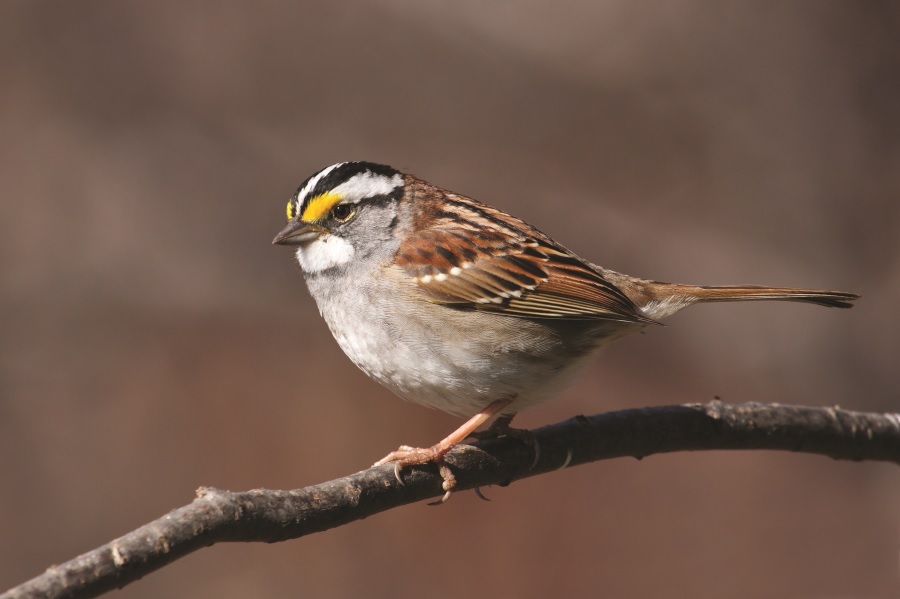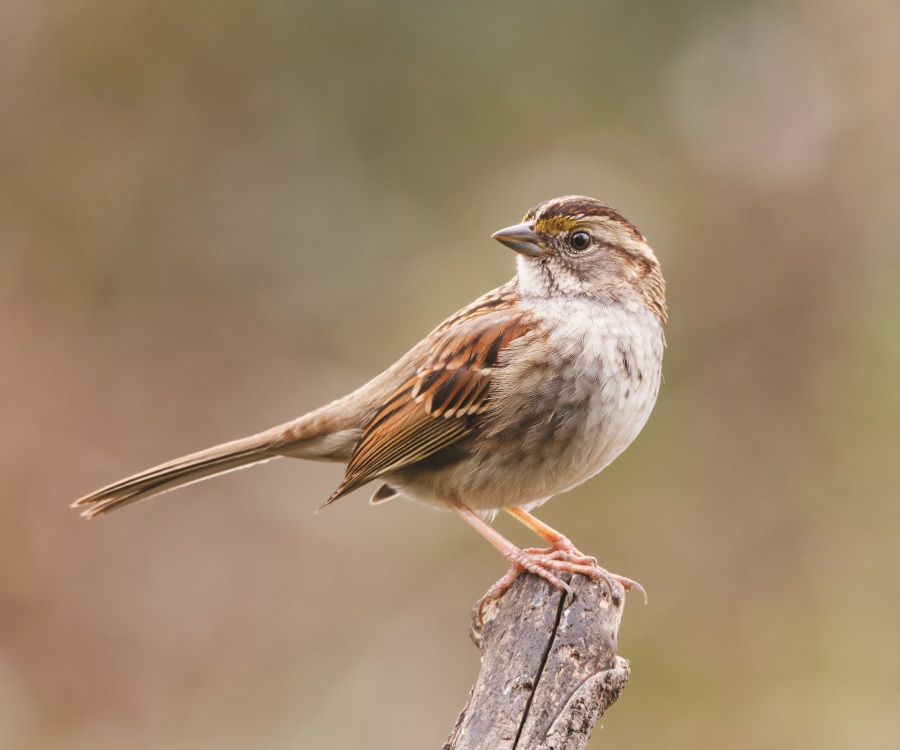For birders, fall is not just one season. The whole period from July to December is characterized by southbound migration, sure. But really, a birder’s fall is a string of many smaller overlapping seasons — periods characterized by the birds that migrate during them: shorebirds, warblers, ducks.
Around the beginning of October is sparrow season, when shrubby edges and weedy fields fill with these brown, streaky birds through the back half of the fall.
Compared to warblers, the main migrant songbird for the early part of the fall, sparrows are pretty unobtrusive. But the season still offers some surprises. Within the flocks of song, swamp, and chipping sparrows, you might be lucky enough to find some rarer birds, like vesper and clay-colored, both visitors from points west.

Among the most numerous arrivals are the white-throated sparrows. These chunky brownish birds have a distinctive facial pattern: white throat, gray cheek, black eyeline, a yellow spot near the bill, and an array of five black-and-white stripes on the head. They appear on the Outer Cape in late September and overwinter here, not leaving until the end of May.
Sparrows might strike you as ordinary. But you’d be hard pressed to find a more fascinating species on Cape Cod — at least when it comes to this bird’s sex life.
I referred to the stripes on top of the white-throated sparrows’ heads as black and white, but this isn’t really true: about half of these sparrows have tan stripes instead of white ones, giving them a more muted, messy appearance overall. These were once thought to be young birds. We now know, however, that these birds are no older or younger than their white-striped counterparts: they are simply an alternate color morph.
Color morphs are found in a variety of the birds of Cape Cod: eastern screech-owls may have gray or red plumage, for instance, or snow geese may have all-white bodies or black bodies with white heads.
The genetics behind the two-color morphs of the white-throated sparrow lie in a pair of chromosomes labeled chromosome 2. In tan-striped birds, the chromosomes are identical, but in white-striped birds, one of the pair has a section in the middle that is inverted — as if you pulled a section out of the middle of a deck of cards, flipped it upside down, and stuck it right back in.
These genetics determine more than mere stripe color. On their breeding grounds in the boreal forests, white-striped individuals are much more aggressive than tan-striped birds. White-striped males sing more often, are more likely to encroach on other birds’ territories, and try to mate with more females. White-striped females, similarly, are nearly twice as likely to try to mate with males as their tan-striped counterparts. Perhaps unsurprisingly, this focus on mating makes white-striped birds neglectful parents.
Compare this to the tan-striped birds, whose males invest a lot of energy in protecting their mates and raising their young.
Both strategies are successful: the low-investment white-stripes and the high-investment tan-stripes both produce ample young and appear with about equal frequency in the population of these sparrows.
You might think that these two morphs would somewhat self-segregate: tan-striped males would mate with tan-striped females and vice-versa, preferring mates who share their parenting strategies. But it turns out that, for white-throated sparrows, opposites attract. With remarkable consistency, tan-striped females mate with white-striped males, and white-striped females mate with tan-striped males.

Eliana Tuttle discovered this strange mating system. She studied white-throated sparrows from the early 1990s until her death in 2016, including Ph.D. work at SUNY’s Cranberry Lake Biological Station and at Indiana State University, where she was a biology professor. What she found was that 98.5 percent of these sparrows tend to mate with birds that have opposite stripe patterns.
It seems evolution rewards this system, too. Birds that are born from white-white or tan-tan parents show signs of being underfed and likely suffer from a glut of recessive genes. The offspring of different colored pairs, meanwhile, tend to be much healthier.
Laboratory experiments have examined how this phenomenon works. When both white- and tan-striped females are presented with a choice between white- and tan-striped males, both varieties will choose the tan-striped males. Similarly, both types of males appear to be more attracted to the white-striped females.
The scientists behind these experiments suggest that the more aggressive white-striped females push away and outcompete the more timid tan-striped females to win the loyal tan-striped males. This leaves the tan-striped females to mate with the brash, careless white-striped males. In short, the dominant females choose the good fathers, while the meeker females are stuck with the deadbeat dads.
When explained in these terms, the whole arrangement seems simple. These aren’t just different behavioral types, though. There’s more to it than that. It turns out that white- and tan-striped birds are genetically very different, and their offspring will suffer if they don’t mate a certain way. The inversion essentially turns chromosome pair 2 into a second set of sex chromosomes, and white- and tan-striping into a second sexual binary.
In other words: these birds are the only animal on the planet known to have four sexes.
We are spoiled on Cape Cod to have a bird like in such abundance. By the end of October, seemingly every patch of brush and overgrown field will be loaded with white-throated sparrows, white- and tan-striped alike. The next time you come across a flock of these birds, take a moment to stop and appreciate the random chance and evolutionary power that created such a unique work of nature.



